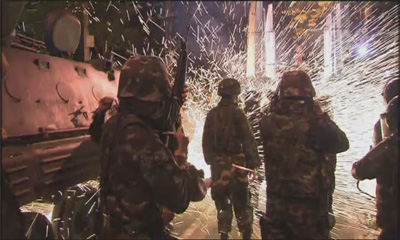Two journalists died and several others were injured during the country’s political unrest. A CPJ investigation has found that both security forces and protesters engaged in reckless behavior—and in the aftermath, the government has done little to bring anyone to account. A CPJ special report by Shawn W. Crispin
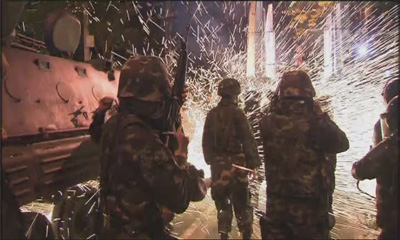
Posted July 29, 2010
BANGKOK, Thailand
After Thai security forces and antigovernment protesters clashed in a series of armed confrontations in April and May, both sides in the political conflict claimed to have exercised restraint. At least 90 people were killed and more than 1,800 injured in the violence, some of the worst civil strife to hit Thailand since troops opened fire on pro-democracy demonstrators in 1992.
More on this issue
• CPJ’s recommendations
• Muramoto’s last footage
• Database of journalists killed
Prime Minister Abhisit Vejjajiva’s government has maintained that troops used live ammunition only in self-defense, and that its crowd-control measures were consistent with international standards. The United Front for Democracy Against Dictatorship (UDD) protest group, whose leaders took cues from self-exiled former premier Thaksin Shinawatra, claimed throughout its nine-week demonstration that its supporters, known for their red shirts, were peaceful and unarmed.
Despite those assertions, a CPJ examination has found that both sides engaged in lethal recklessness that led to the deaths of two journalists—Fabio Polenghi, an Italian freelance photographer, and Hiro Muramoto, a Japanese cameraman for Reuters—along with injuries to nine other reporters and photographers. Two dozen journalists who covered the conflict and spoke with CPJ offered accounts that were substantially different than those presented by the government and the UDD, describing events that transformed areas of Bangkok into an unpredictable and chaotic war zone.
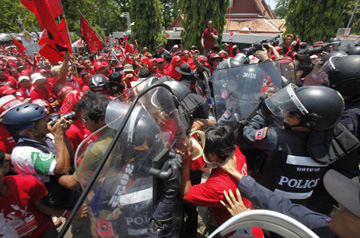
Journalists said that in several instances troops fired in a random manner into crowds of apparently unarmed demonstrators, frequently in areas where reporters were present. Their news reports and interviews with CPJ also highlighted the presence of heavily armed, black-clad protesters who fired gunshots and launched grenades at troops deployed in areas where journalists were positioned.
Preliminary government investigations into the violence have been incomplete and opaque, as have the autopsies of the two journalist victims, CPJ has found. Private investigations launched by concerned news organizations, foreign embassies, and family members of the deceased have been obstructed or denied access to key information in the government’s possession. Thus far, no one has been brought to account for the killings and the other critical injuries.
Although several UDD leaders are in detention and face possible “terrorism” charges, there is no precedent to believe that the Thai government will bring any of its security forces to account for abuses. The head of the government’s main fact-finding committee into the unrest has publicly said that his panel doesn’t intend to assign blame. But because foreign reporters were among those killed, official obfuscation could have diplomatic repercussions for Thailand, particularly with its largest foreign investor, Japan.
In Polenghi shooting, an opaque inquiry
The death of Italian photographer Fabio Polenghi is at the center of the competing versions of events. Polenghi, 48, was killed by gunfire on the morning of May 19 while reporting on military operations to dislodge demonstrators along Rajadamri Road, a perimeter of the elaborate protest site the UDD had built in Bangkok’s top commercial district.
Bradley Cox, a Bangkok-based documentary filmmaker, said that earlier that morning troops had fired sporadically from behind a barricade into areas 200 meters away that were controlled by the UDD. Cox said both he and Polenghi had taken footage of a protester shot in the leg at around 10:45 a.m.
At 10:58 a.m., sensing a lull in the shooting, Cox said he moved away from a barricade controlled by the UDD and into the nearly empty road to investigate a commotion among protesters approximately 30 to 40 meters away. Cox said he believes Polenghi followed a few steps behind.
While running down the road, Cox felt a sudden, sharp pain in the side of his leg. It turned out that a bullet had grazed his knee, causing minor injury. When he turned to look back in the direction of the troops, he saw Polenghi sprawled on the ground about two or three meters behind him. Polenghi was wearing a blue helmet with the word “Press” written across the front and back, and a green armband indicating that he was a working journalist.
“My feeling at the time was that we were shot at the exact same time, perhaps even with the same bullet,” said Cox, adding that he didn’t hear the gunshot or shots that hit him or Polenghi. “I don’t know who shot me or Fabio, but if the military was trying to shoot red shirts, there was no one around us. … Soldiers were firing at anything or anybody.”
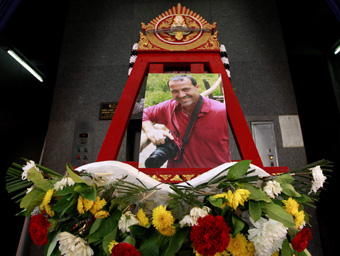
Video footage Cox subsequently took of journalists and protesters who carried Polenghi’s body out of the road and onto a motorcycle bound for a nearby local hospital appeared to show a bullet had entered Polenghi’s body under his left armpit and exited through his side. He was declared dead on arrival at a local hospital, according to news reports. Authorities did not report any bullet being recovered.
Polenghi’s family has expressed concerns about the government’s opaque response to his death. His sister, Elisabetta Polenghi, told CPJ that her family has repeatedly requested, but has not received, an official autopsy report. She said there are conflicting accounts from police and the Justice Ministry about the precise location of her brother’s wounds, which she did not see herself before his body was cremated. She also noted that many of Polenghi’s personal belongings, including his camera and telephone, are now missing. Such contradiction and obfuscation have fueled her fears that Polenghi could have been targeted for being a journalist.
She and a group of Polenghi’s colleagues have pieced together video clips—some received from journalists who were in Polenghi’s vicinty, others downloaded from unknown sources on the Internet—to develop a timeline of movements before and after the shooting. There is no known footage of the shooting itself. One video clip shows that an unidentified man wearing a silver helmet was the first to reach Polenghi after he was shot. The brief footage shows him feeling around Polenghi’s chest and briefly jostling with his camera, while another unidentified man wearing a yellow helmet kneels and takes his photograph.
Cox’s footage appears to show the same men being among those who moved Polenghi’s body out of the road and onto the motorcycle that took him to the hospital. The silver-helmeted man’s picture has been published in both the Thai Rath and Matichon newspapers, but neither he nor the other helmeted man has been identified, Elisabetta Polenghi said.
Government spokesman Panitan Wattanayagorn did not respond to questions from CPJ on the Polenghi shooting, including the assertion that soldiers were firing indiscriminately, or on details of the other shootings. Sek Wannamethee, deputy chief of mission for Thailand’s embassy in Washington, responded broadly to CPJ’s concerns in a June 14 letter that said the government regretted the loss of life and was committed to investigating the deaths fully and impartially.
Government response draws concern
Other on-the-ground reporters narrowly escaped death. Nelson Rand, a freelance contributor to television news channel France 24, was shot in the wrist, leg, and abdomen while covering a gun battle on May 14 outside of the city’s Lumpini Park.
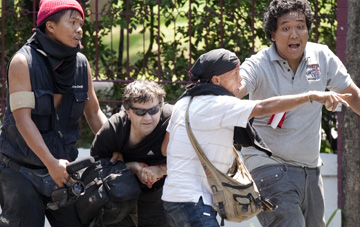
CPJ reviewed video footage of the shooting that appears to show that the gunfire that struck Rand in the leg and abdomen came from a position where troops were stationed that day. The footage was shot by a freelance journalist who provided it to CPJ for review on condition of anonymity. After crying out for help, the video shows, Rand was rescued by an unarmed UDD protester who dragged him out of the line of fire. The protester and a fellow demonstrator drove an unconscious Rand to a nearby hospital, where the journalist underwent emergency surgery.
“The bottom line is I did not see who shot me and therefore I don’t know,” said Rand, who spent more than two weeks in the hospital recuperating but still cannot work because of the severity of his injuries. “I knew the risks involved and I ended up paying for it.” Despite the international media attention given to his case, Rand said no police or government official ever approached him about the shooting.
The government has announced plans to launch various independent and quasi-independent investigations into the recent rash of deaths and injuries of security forces, protesters, and other civilians during the April-May political unrest. Separate probes will be led by the police Department of Special Investigations, the quasi-independent National Anti-Corruption and National Human Rights commissions, as well as an independent fact-finding committee chaired by former Attorney General Khanit na Nakorn.
Concerns have already emerged that the investigations will not bring perpetrators to justice, particularly if they are government agents. Khanit was quoted in the local press on June 12 saying that “there will be no pointing fingers in the [committee’s] work plan” and that “placing blame was less important than promoting forgiveness.” He has said that it will take his panel two years to finish its work.
Questions linger in Muramoto death
A recently completed private investigation commissioned by Reuters into the fatal shooting of its cameraman, Hiro Muramoto, has moved more swiftly despite official obstruction, according to people familiar with the situation. Muramoto, 43, was shot and killed while covering the first armed clashes between antigovernment protesters and Thai security forces, on April 10, in Bangkok’s Old Town area.
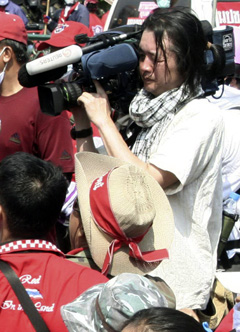
While positioned with the military that evening, Muramoto had captured on film a grenade attack that had killed and severely wounded a number of troops. He was later seen on the side of the protesters, four of whom were photographed by the local Daily News newspaper carrying his limp body away from the frontlines at around 9 p.m.
Reuters’ investigation, which drew on information from two unnamed eyewitnesses, found that Muramoto “was shot almost certainly by a high velocity bullet fired at street level while standing in a street between Thai troops and red shirt protesters.” A summary reviewed by CPJ said that Muramoto “was not shot at close range” and that “both troops and protesters had high velocity weapons at the time of Hiro’s death and there were casualties on both sides that night.”
Those findings contradict earlier government suggestions that Muramoto may have been shot from above by a UDD sniper positioned on a nearby rooftop. What remains unclear, however, is which direction the fatal bullet was fired, according to Jason Szep, the news agency’s Thailand bureau chief.
An initial government autopsy revealed only that a bullet fired from a high velocity rifle entered under Muramoto’s right armpit and exited through his back. The veteran reporter most likely died from massive internal bleeding and his pulse had already stopped when he arrived at the hospital, according to Szep.
The bullet, which if found would carry important clues in determining whether Muramoto was shot by troops or protesters, has not been recovered—or least not made available for inspection to outside investigators, according to people familiar with the situation.
“Our initial concern was that he was targeted,” Szep said, referring to his bureau’s original fear that Muramoto may have taken footage perceived as sensitive by one side. “Now, we don’t think he was. All signs point to him being at the wrong place at the wrong time at a very dangerous moment.”
One Bangkok-based diplomat with knowledge of a separate private investigation claimed that the government has in its possession, but has refused to release, closed circuit television footage of the Din Saw Street area where Muramoto is believed to have been around the time of his death. He said that the monitoring camera was situated on a pole outside of a local school and that its recorded contents could provide important clues about Muramoto’s death.
One theory pursued but not conclusively proven by private investigators is that Muramoto was shot while positioning himself to take footage of a UDD protester who was on the ground after being shot in the head. The protester was hit in the same area Muramoto was believed to have been killed approximately 10 minutes later. Muramoto had continued filming until shortly before he was killed, but his camera was off at the time of his death, according to Szep.
A CPJ source familiar with one private investigation into Muramoto’s death claimed that the government is “dragging its feet” in finalizing the results of its forensic investigation. He noted that a Bangkok Post report published in late April quoted a forensics official saying that Muramoto was most likely killed by a soldier’s bullet. As of July, the government still had not released the full results of the official autopsy.
The same source, who has knowledge of details of the investigation, said the military has declined to make soldiers believed to have been near Muramoto available for interviews with private investigators. In particular, the investigators unsuccessfully sought access to a soldier who had asked Muramoto to descend an armored personnel carrier the reporter had climbed up to gain a heightened perspective.
Government pursues a media crackdown
The concerns about official transparency coincide with a mounting government clampdown on the local media and criticism of foreign reporting of recent events. Since declaring a state of emergency on April 7, the government closed an opposition-aligned satellite television station, 26 community radio stations, four print publications, and 32 websites. Officials have justified that censorship on claims that partisan media were used by the UDD to incite violence.
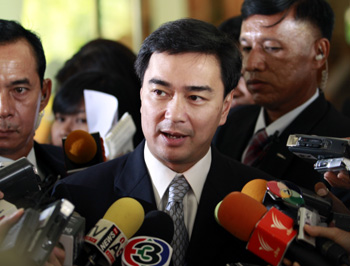
At the same time, the government has won some praise from the press for allowing journalists access to the political unrest, including the military’s armed suppression of the protests, while the emergency decree was in effect. “The Thai government must be credited for not blocking the way of journalists covering recent events,” said Marawan Macan-Markar, president of the Foreign Correspondents Club of Thailand. “There were no limits on embedding, no policies, and no efforts to stop you from reporting.”
But chaotic conditions also created grave risk. Chandler Vandergrift, a freelance reporter on assignment for the Toronto Star, suffered near-fatal injuries after being hit by grenade shrapnel in the back and head on the afternoon of May 19. Vandergrift was positioned with a group of soldiers at the time of the grenade attack and fell immediately unconscious from his injuries, he told CPJ.
He said that it took six weeks for some of the two dozen shrapnel wounds on his back to stop bleeding and that the grenade’s blast has left him completely deaf in his left ear. Vandergrift said he believes that the grenade that hit him was fired by black-clad armed protesters, who in his estimation were targeting troops, not journalists.
Atit Perawongmetha, a freelance photographer who contributes to Getty Images, told CPJ that the grenade that exploded near Vandergrift was one of a barrage of five launched from an area under UDD control toward soldiers positioned at a corner of Lumpini Park.
“At first I didn’t think anyone was hurt. Then I saw Chandler and two soldiers were down,” Atit said. “A soldier checked Chandler’s pulse and said he was dead, but I saw that he was still breathing. Everyone was too scared to move until 10 minutes later soldiers helped move him across the street to a safe area. … Everybody was in shock because we almost died; many were weeping, including myself.”
Vandergrift told CPJ that surgeons were unable to remove one piece of shrapnel, which is still lodged in the front of his head. At the time of his injury, Vandergrift was wearing only a plastic motorcycle helmet, underscoring the life-threatening risks many reporters took while reporting on a conflict where the frontlines were often obscured.
Although Vandergrift believes that those responsible for firing the grenade that caused his injuries could rightfully be charged with “terrorism,” no government officials have formally contacted him about the shooting. “I don’t expect to receive justice,” said Vandergrift in a Bangkok coffeeshop overlooking the park where he was injured. “Nobody receives justice in Thailand. Why would I?”
In his June 14 letter to CPJ, Thailand chief of mission Sek wrote that “security forces made every effort to inform the press and the public of the dangers they faced” and that government agencies have been in contact with the Foreign Correspondents Club “to find ways to enhance the security and safety of journalists.” But without serious and thorough investigations into the deaths of Muramoto, Polenghi, and the assaults on other reporters in the field, there is no guarantee that journalists will be any safer reporting on future unrest in Thailand.
Shawn W. Crispin is CPJ’s senior Southeast Asia representative.
CPJ’s Recommendations
The Committee to Protect Journalists calls on the government of Thailand to:
- Complete the official autopsies and police investigations into the shooting deaths of Fabio Polenghi and Hiro Muramoto. Undertake thorough and impartial investigations into the wounding of nine other journalists, including Nelson Rand and Chandler Vandergrift. Where criminal liability is found, file charges and prosecute the perpetrators. Where military forces acted outside accepted standards, subject the individuals to military discipline.
- Cooperate with independent investigations probing the circumstances surrounding the killing and wounding of journalists. Where no legal impediments exist, disclose the results of official autopsies and police investigations. Make available all closed circuit television footage and other relevant forensic evidence now in the government’s possession.
- Refocus the duties of the main government-appointed fact-finding panel to include bringing to justice the perpetrators of violence against journalists.
- Repeal the state of emergency in effect in Bangkok and 15 other provinces and stop censoring media, including online publications, for national security reasons.
- Ensure that military forces take all reasonable precautions to prevent unnecessary risk to journalists covering political unrest
